TOYOTA PROACE VERSO 2020 Owners Manual
Manufacturer: TOYOTA, Model Year: 2020, Model line: PROACE VERSO, Model: TOYOTA PROACE VERSO 2020Pages: 418, PDF Size: 39.32 MB
Page 91 of 418
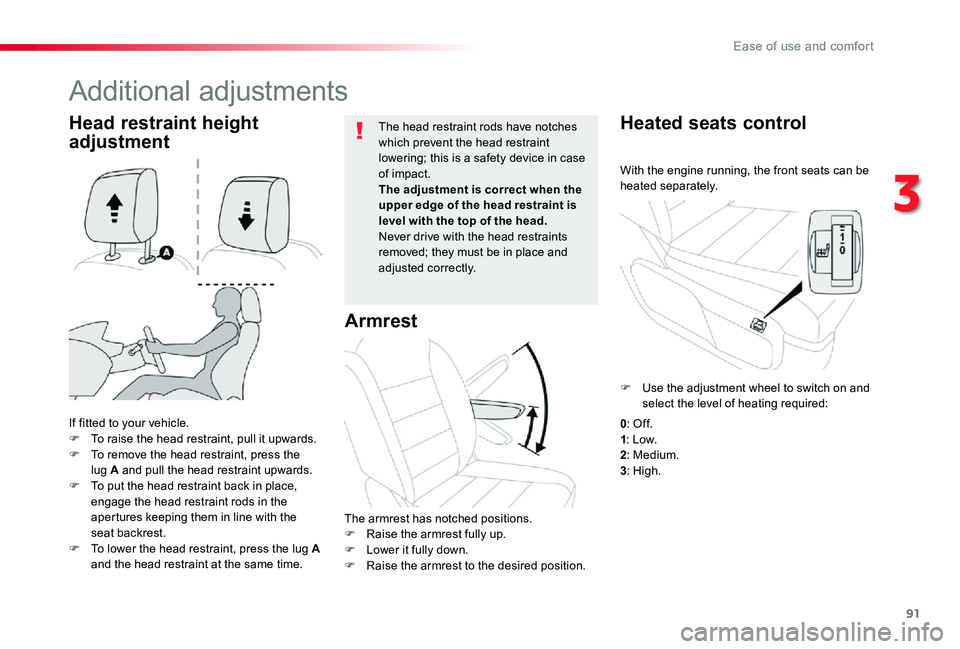
91
With the engine running, the front seats can be heated separately.
Heated seats control
If fitted to your vehicle.F To raise the head restraint, pull it upwards.F To remove the head restraint, press the lug A and pull the head restraint upwards.F To put the head restraint back in place, engage the head restraint rods in the apertures keeping them in line with the seat backrest.F To lower the head restraint, press the lug A and the head restraint at the same time.
The head restraint rods have notches which prevent the head restraint lowering; this is a safety device in case of impact.The adjustment is correct when the upper edge of the head restraint is level with the top of the head.Never drive with the head restraints removed; they must be in place and adjusted correctly.
Head restraint height
adjustment
Additional adjustments
Armrest
The armrest has notched positions.F Raise the armrest fully up.F Lower it fully down.F Raise the armrest to the desired position.
F Use the adjustment wheel to switch on and select the level of heating required:
0: Of f.1: Low.2: Medium.3: High.
3
Ease of use and comfort
Page 92 of 418
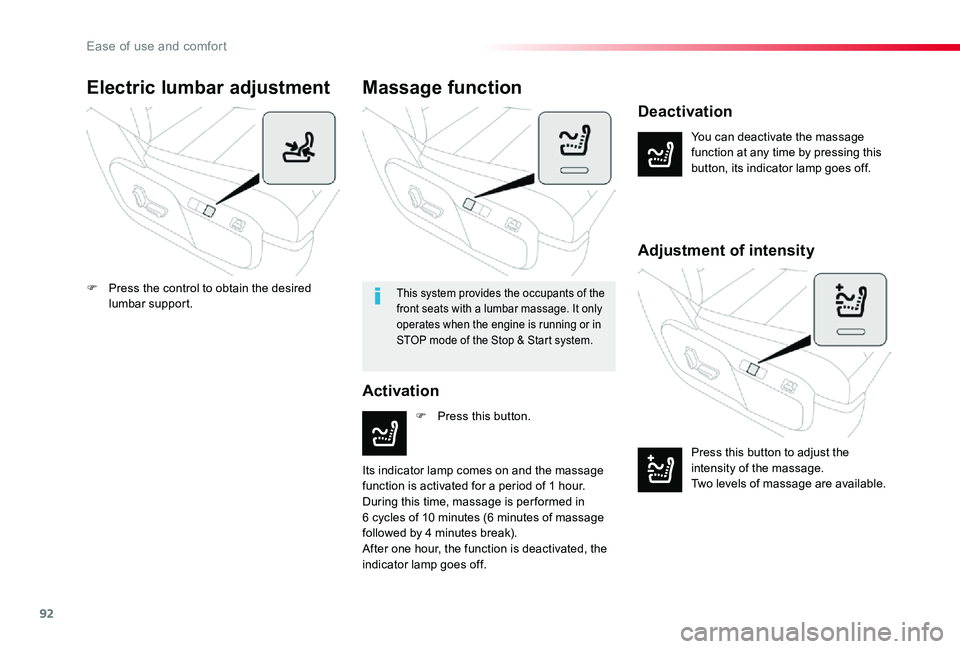
92
Electric lumbar adjustment
You can deactivate the massage function at any time by pressing this button, its indicator lamp goes off.
Deactivation
Activation
Massage function
F Press this button.
Its indicator lamp comes on and the massage function is activated for a period of 1 hour.During this time, massage is per formed in 6 cycles of 10 minutes (6 minutes of massage followed by 4 minutes break).
After one hour, the function is deactivated, the indicator lamp goes off.
Adjustment of intensity
Press this button to adjust the intensity of the massage.Two levels of massage are available.
F Press the control to obtain the desired lumbar support.This system provides the occupants of the front seats with a lumbar massage. It only operates when the engine is running or in STOP mode of the Stop & Start system.
Ease of use and comfort
Page 93 of 418
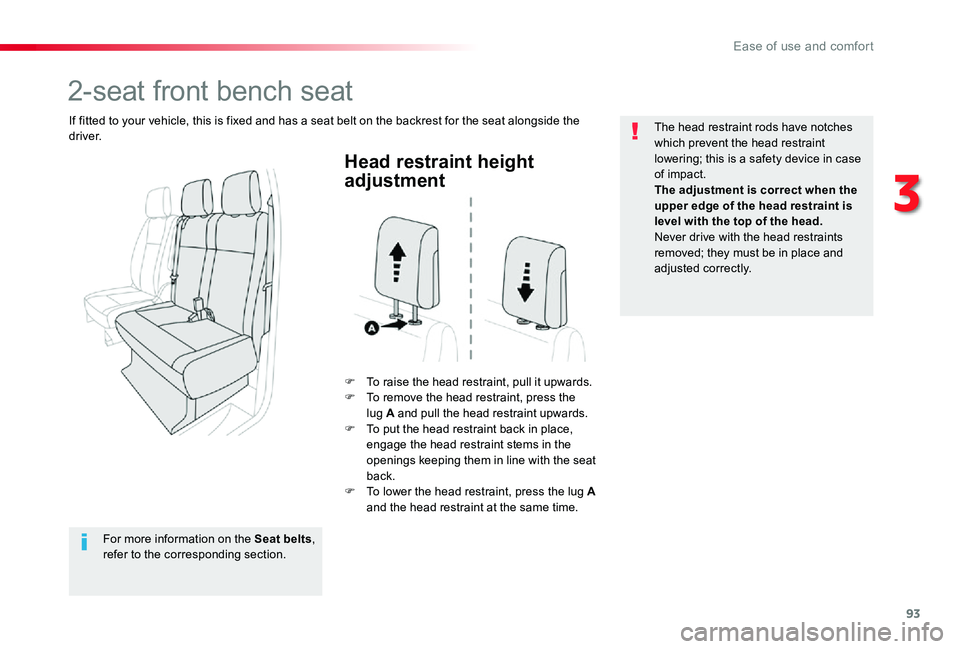
93
Head restraint height
adjustment
F To raise the head restraint, pull it upwards.F To remove the head restraint, press the lug A and pull the head restraint upwards.F To put the head restraint back in place, engage the head restraint stems in the openings keeping them in line with the seat back.F To lower the head restraint, press the lug A and the head restraint at the same time.
The head restraint rods have notches which prevent the head restraint lowering; this is a safety device in case of impact.The adjustment is correct when the upper edge of the head restraint is level with the top of the head.Never drive with the head restraints removed; they must be in place and adjusted correctly.
2-seat front bench seat
If fitted to your vehicle, this is fixed and has a seat belt on the backrest for the seat alongside the driver.
For more information on the Seat belts, refer to the corresponding section.
3
Ease of use and comfort
Page 94 of 418
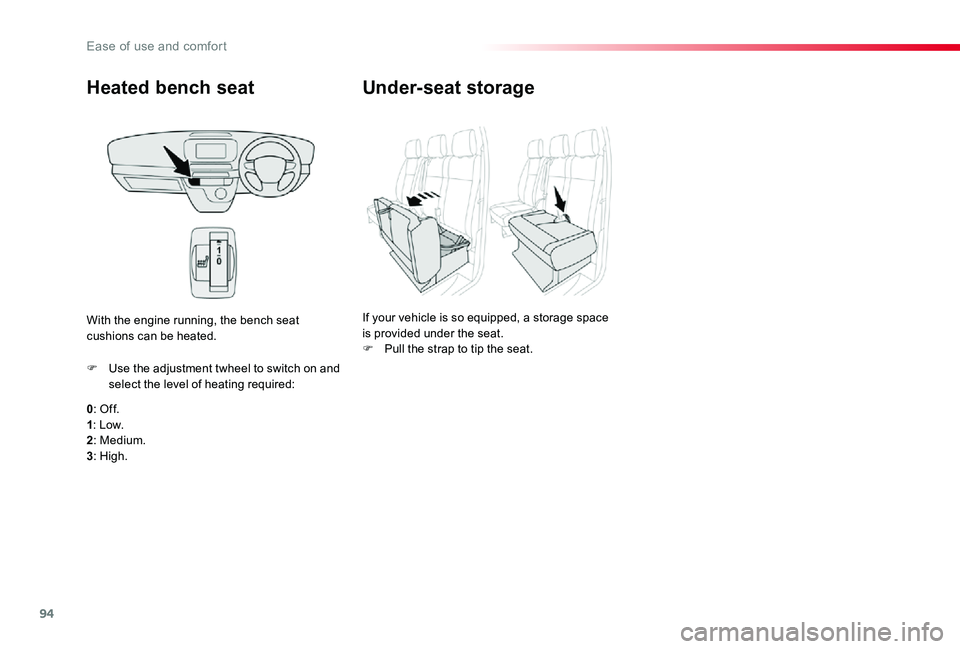
94
Heated bench seat
0: Of f.1: Low.2: Medium.
3: High.
F Use the adjustment twheel to switch on and select the level of heating required:
With the engine running, the bench seat cushions can be heated.
Under-seat storage
If your vehicle is so equipped, a storage space is provided under the seat.F Pull the strap to tip the seat.
Ease of use and comfort
Page 95 of 418

95
Fixed one-piece bench seat
F To raise a head restraint, pull it up until it engages in its notches.F To remove the head restraint, press the lug A and pull the head restraint upward.F To put it back in place, engage the head restraint rods in the apertures keeping them in line with the seat backrest.F To lower it, press on the lug A and on the head restraint at the same time.
F Place the head restraints in the low position
The different items of equipment and adjustments described hereafter vary according to the version and the configuration of your vehicle.
Angled head restraintsFolding the seat backrest to
the table position
For more information on the Seat belts,
refer to the corresponding section.
The bench seat includes a one-piece backrest which may be fixed or folding (table position).F From the front, raise the handle to release the seat backrest.F From the rear, lower the handle to release the seat backrest.F Fold the backrest onto the seat cushion.F To return the backrest to its normal position, raise the handle and pull the backrest up.
3
Ease of use and comfort
Page 96 of 418
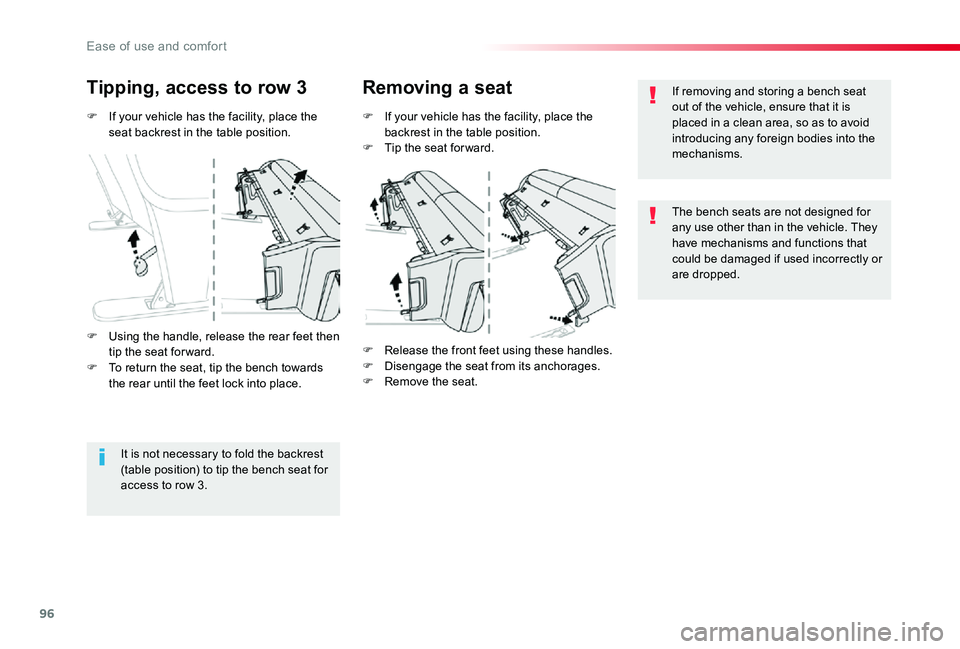
96
F If your vehicle has the facility, place the seat backrest in the table position.
Tipping, access to row 3Removing a seat
F If your vehicle has the facility, place the backrest in the table position.F Tip the seat for ward.
F Using the handle, release the rear feet then tip the seat for ward.F To return the seat, tip the bench towards the rear until the feet lock into place.
It is not necessary to fold the backrest (table position) to tip the bench seat for access to row 3.
F Release the front feet using these handles.F Disengage the seat from its anchorages.F Remove the seat.
If removing and storing a bench seat out of the vehicle, ensure that it is placed in a clean area, so as to avoid introducing any foreign bodies into the mechanisms.
The bench seats are not designed for any use other than in the vehicle. They have mechanisms and functions that
could be damaged if used incorrectly or are dropped.
Ease of use and comfort
Page 97 of 418
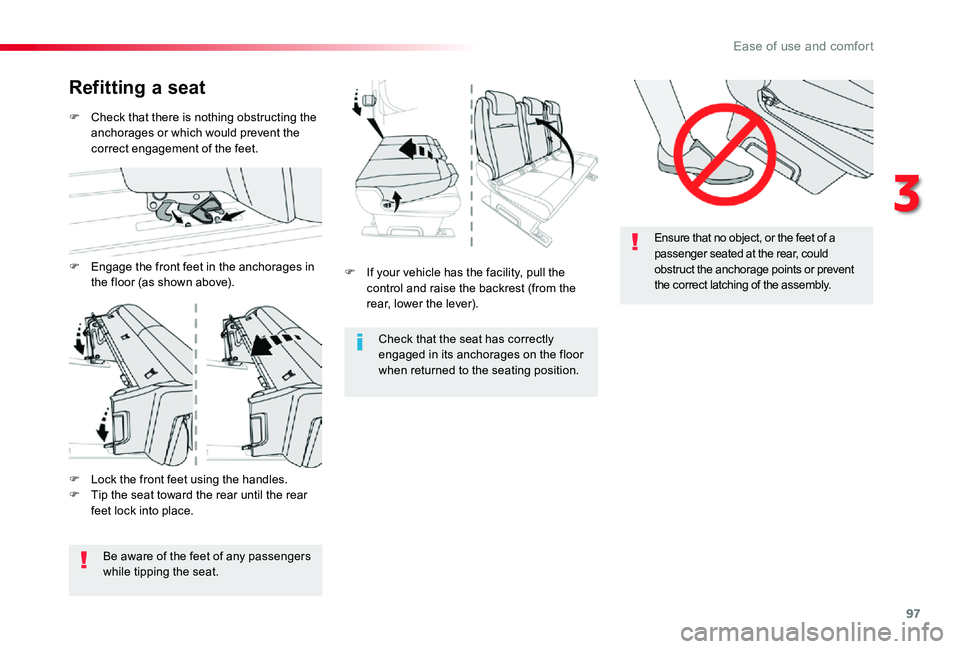
97
Ensure that no object, or the feet of a
passenger seated at the rear, could obstruct the anchorage points or prevent the correct latching of the assembly.F If your vehicle has the facility, pull the control and raise the backrest (from the rear, lower the lever).
Check that the seat has correctly engaged in its anchorages on the floor when returned to the seating position.
Refitting a seat
F Engage the front feet in the anchorages in the floor (as shown above).
F Check that there is nothing obstructing the anchorages or which would prevent the correct engagement of the feet.
F Lock the front feet using the handles.F Tip the seat toward the rear until the rear feet lock into place.
Be aware of the feet of any passengers while tipping the seat.
3
Ease of use and comfort
Page 98 of 418
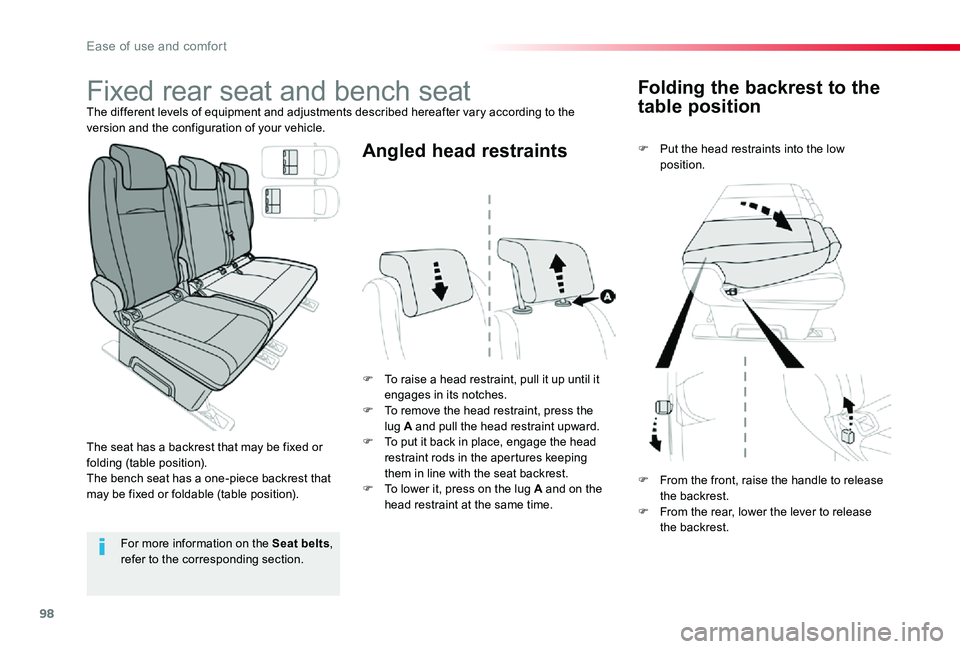
98
Folding the backrest to the
table position
F Put the head restraints into the low position.
F To raise a head restraint, pull it up until it engages in its notches.F To remove the head restraint, press the lug A and pull the head restraint upward.F To put it back in place, engage the head restraint rods in the apertures keeping them in line with the seat backrest.F To lower it, press on the lug A and on the head restraint at the same time.
Angled head restraints
For more information on the Seat belts, refer to the corresponding section.
F From the front, raise the handle to release the backrest.F From the rear, lower the lever to release the backrest.
Fixed rear seat and bench seatThe different levels of equipment and adjustments described hereafter vary according to the version and the configuration of your vehicle.
The seat has a backrest that may be fixed or folding (table position).The bench seat has a one-piece backrest that may be fixed or foldable (table position).
Ease of use and comfort
Page 99 of 418
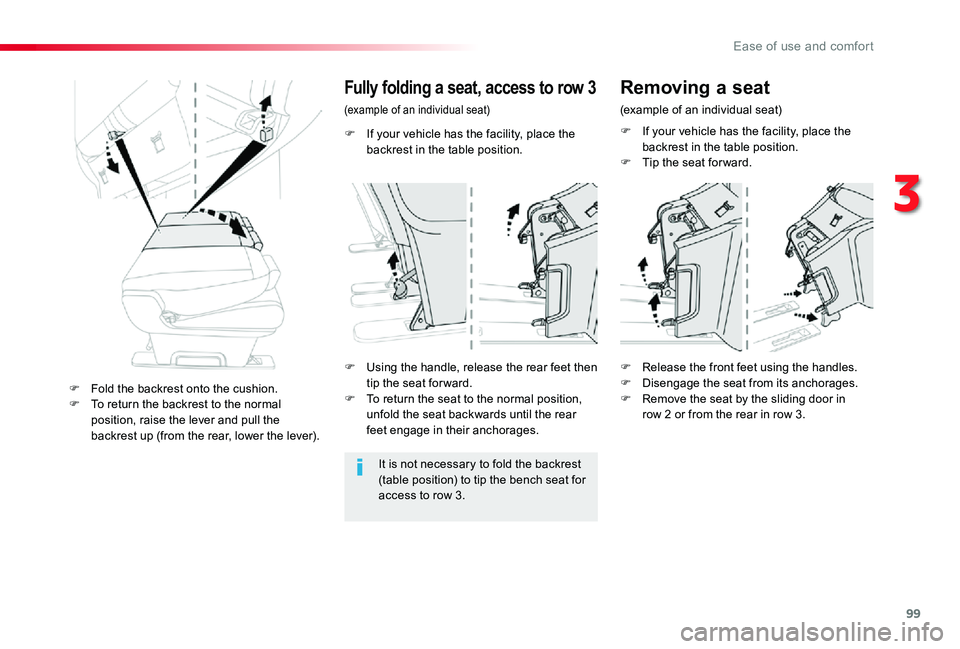
99
F If your vehicle has the facility, place the backrest in the table position.
Fully folding a seat, access to row 3
(example of an individual seat)
It is not necessary to fold the backrest (table position) to tip the bench seat for access to row 3.
F Using the handle, release the rear feet then tip the seat for ward.F To return the seat to the normal position, unfold the seat backwards until the rear feet engage in their anchorages.
F Fold the backrest onto the cushion.F To return the backrest to the normal position, raise the lever and pull the backrest up (from the rear, lower the lever).
Removing a seat
(example of an individual seat)
F If your vehicle has the facility, place the backrest in the table position.F Tip the seat for ward.
F Release the front feet using the handles.F Disengage the seat from its anchorages.F Remove the seat by the sliding door in row 2 or from the rear in row 3.
3
Ease of use and comfort
Page 100 of 418
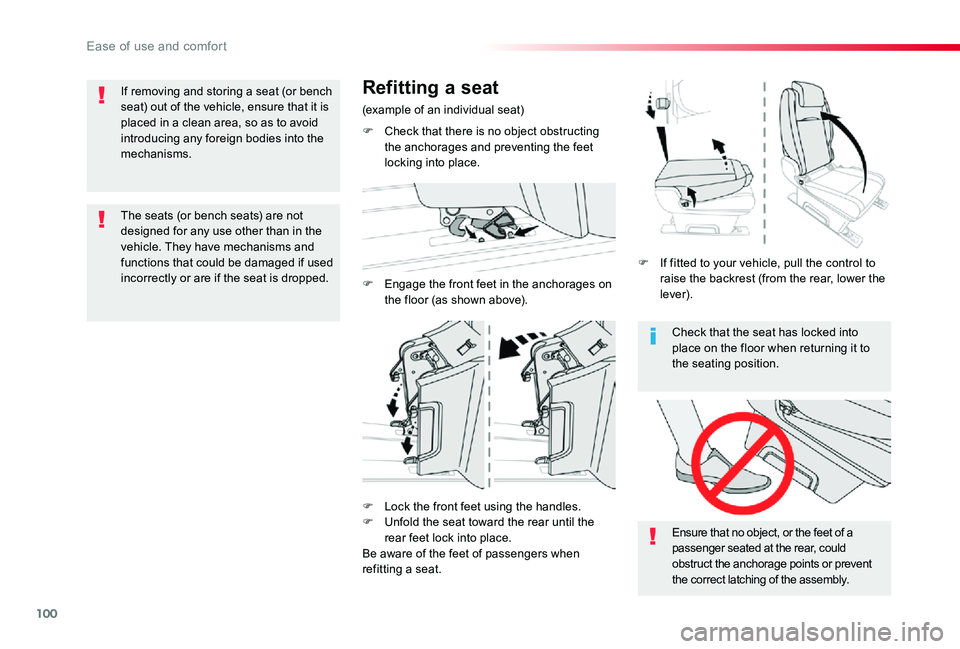
100
Check that the seat has locked into place on the floor when returning it to the seating position.
Ensure that no object, or the feet of a passenger seated at the rear, could obstruct the anchorage points or prevent the correct latching of the assembly.
Refitting a seat
(example of an individual seat)
F Check that there is no object obstructing the anchorages and preventing the feet locking into place.
F Engage the front feet in the anchorages on the floor (as shown above).
F Lock the front feet using the handles.F Unfold the seat toward the rear until the rear feet lock into place.Be aware of the feet of passengers when refitting a seat.
F If fitted to your vehicle, pull the control to raise the backrest (from the rear, lower the lever).
If removing and storing a seat (or bench seat) out of the vehicle, ensure that it is placed in a clean area, so as to avoid introducing any foreign bodies into the mechanisms.
The seats (or bench seats) are not designed for any use other than in the vehicle. They have mechanisms and functions that could be damaged if used incorrectly or are if the seat is dropped.
Ease of use and comfort